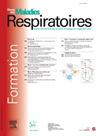Difference in the inflammatory response and the corticoid response of human lung macrophages and parenchymal explants to ex-vivo cigarette smoke exposure
IF 0.5
4区 医学
Q4 RESPIRATORY SYSTEM
引用次数: 0
Abstract
Introduction
COPD affects approximately 10% of the global population, with three million annual deaths. About half of COPD cases are linked to smoking, but fewer than 50% of heavy smokers develop the disease. The pharmacoloical treatment of stable COPD relies on inhaled bronchodilators and corticosteroids (ICS). The ICS use benefit in terms of lung function and exacerbation rates to both current and ex-smokers with COPD although the magnitude of the effect is lower in heavy or current smokers compared to light or ex-smokers. Cigarette smoke (CS), rich in free radicals, increases immune cells recruitment in the lungs, particularly alveolar macrophages (AM) [1]. Studies show varied results on the production of pro-inflammatory cytokines by AMs in smokers vs. ex- or non-smokers. Moreover, there is also a large variation in the therapeutic response to ICS in COPD patients. The lack of clear data prevents an objective view of the impact of CS on AM activation and their sensitivity to corticosteroids. This study evaluates the inflammatory responses induced by cigarette smoke extracts (CSE) on human lung macrophages in vitro and compares the effect of budesonide (BUD) under conditions exposed to CSE or LPS.
Methods
Lung tissues were obtained from 51 patients undergoing surgical resection for lung cancer. Peripheral tissues distant from the tumor were carefully dissected. Lung macrophages (LM) were isolated through cell adhesion from the peripheral tissue supernatant [2], while parenchymal explants (PE) were prepared by dissecting 50 mg fragments from the lung tissues. LM and PE were cultured separately in a warm medium containing cigarette smoke extract (CSE) at concentrations of 1%, 5%, and 7.5% for 24 hours. In some experiments, LPS (10 ng/mL for LM, 1 μg/mL for PE) or TNF-α (10 ng/mL) was added to the culture one hour after CSE stimulation. Additionally, in certain conditions, LM or PE stimulated with CSE were pre-incubated with BUD at concentrations of 10−10, 10−9, and 10−8 M for 30 minutes before LPS stimulation. After 24 hours, supernatants were collected, and cytokine production (TNF-α, IL-6, CCL2, CCL4, CXCL1, CXCL5, and CXCL8) was measured in the LM and PE supernatants using ELISA.
Results
Our results show that CSE, both with and without stimulation by LPS or TNF-α, modulates the production of pro-inflammatory cytokines such as TNF-α, IL-6, CCL2, CCL4, CXCL1, CXCL5, and CXCL8 in LM. In contrast, these treatments did not have significant effects on cytokine production in the PE model. Additionally, we observed that the maximum release of pro-inflammatory cytokines by LM was higher when treated with both CSE and BUD compared to treatment with LPS and BUD.
Conclusion
This study has enhanced our understanding of the effects of CSE on LM compared to PE. We demonstrated that CSE alters the inflammatory cytokine and chemokine production in LM, as well as their immune response to LPS and TNF-α in the presence of CSE. Moreover, CSE diminishes the anti-inflammatory effects of BUD on LM. In contrast, PE showed only a weak response to CSE at the doses studied and did not exhibit clear signs of corticosteroid resistance.
人肺巨噬细胞和实质外植体对离体香烟烟雾暴露的炎症反应和皮质激素反应的差异
慢性阻塞性肺病影响全球约10%的人口,每年有300万人死亡。大约一半的慢性阻塞性肺病病例与吸烟有关,但只有不到50%的重度吸烟者会患上这种疾病。稳定型COPD的药物治疗依赖于吸入支气管扩张剂和皮质类固醇(ICS)。ICS的使用对当前和已戒烟的COPD患者的肺功能和加重率都有好处,尽管与轻度或已戒烟者相比,重度或当前吸烟者的效果要低一些。香烟烟雾(CS)富含自由基,可增加肺部免疫细胞的募集,尤其是肺泡巨噬细胞(AM)[1]。研究表明,吸烟者与非吸烟者相比,AMs产生的促炎细胞因子有不同的结果。此外,COPD患者对ICS的治疗反应也存在很大差异。由于缺乏明确的数据,我们无法客观地观察CS对AM活化的影响及其对皮质类固醇的敏感性。本研究评估了香烟烟雾提取物(CSE)对体外人肺巨噬细胞的炎症反应,并比较了布地奈德(BUD)在暴露于CSE或LPS条件下的作用。方法收集51例肺癌手术切除患者的肺组织。仔细解剖远离肿瘤的周围组织。外周组织上清[2]通过细胞粘附分离肺巨噬细胞(LM),肺组织切片50 mg制备肺实质外植体(PE)。LM和PE分别在含香烟烟雾提取物(CSE)浓度为1%、5%和7.5%的温培养基中培养24小时。在部分实验中,CSE刺激1小时后,在培养物中加入LPS (LM为10 ng/mL, PE为1 ng/mL)或TNF-α (10 ng/mL)。此外,在一定条件下,在LPS刺激之前,用CSE刺激的LM或PE在浓度为10−10、10−9和10−8 M的BUD中预孵育30分钟。24小时后,收集上清液,用ELISA法测定LM和PE上清液中细胞因子(TNF-α、IL-6、CCL2、CCL4、CXCL1、CXCL5和CXCL8)的产量。结果CSE在LPS或TNF-α刺激和不刺激的情况下均可调节LM中促炎细胞因子TNF-α、IL-6、CCL2、CCL4、CXCL1、CXCL5和CXCL8的产生。相反,这些处理对PE模型中细胞因子的产生没有显著影响。此外,我们观察到,与LPS和BUD处理相比,CSE和BUD处理时LM的促炎细胞因子的最大释放量更高。结论与PE相比,本研究加深了我们对CSE对LM影响的认识。我们证明,CSE改变了LM中炎症细胞因子和趋化因子的产生,以及它们对LPS和TNF-α的免疫反应。此外,CSE降低了BUD对LM的抗炎作用。相比之下,PE在研究剂量下对CSE仅表现出弱反应,并且没有表现出明显的皮质类固醇抵抗迹象。
本文章由计算机程序翻译,如有差异,请以英文原文为准。
求助全文
约1分钟内获得全文
求助全文
来源期刊

Revue des maladies respiratoires
医学-呼吸系统
CiteScore
1.10
自引率
16.70%
发文量
168
审稿时长
4-8 weeks
期刊介绍:
La Revue des Maladies Respiratoires est l''organe officiel d''expression scientifique de la Société de Pneumologie de Langue Française (SPLF). Il s''agit d''un média professionnel francophone, à vocation internationale et accessible ici.
La Revue des Maladies Respiratoires est un outil de formation professionnelle post-universitaire pour l''ensemble de la communauté pneumologique francophone. Elle publie sur son site différentes variétés d''articles scientifiques concernant la Pneumologie :
- Editoriaux,
- Articles originaux,
- Revues générales,
- Articles de synthèses,
- Recommandations d''experts et textes de consensus,
- Séries thématiques,
- Cas cliniques,
- Articles « images et diagnostics »,
- Fiches techniques,
- Lettres à la rédaction.
 求助内容:
求助内容: 应助结果提醒方式:
应助结果提醒方式:


